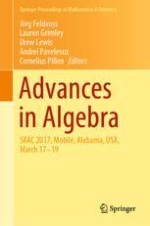The tables of the title are a first attempt to understand empirically the sizes of certain distinguished sets, introduced by Hankyung Ko, of elements in affine Weyl groups. The distinguished sets themselves each have a largest element
w, and all other elements are constructible combinatorially from that largest element. The combinatorics are given in the language of right sets, in the sense of Kazhdan–Lusztig. Collectively, the elements in a given distinguished set parameterize highest weights of possible modular composition factors of the “reduction modulo
p” of a
pth root of unity irreducible characteristic 0 quantum group module. Here,
p is a prime, subject to conditions discussed below, in some cases known to be quite mild. Thus, the sizes of the distinguished sets in question are relevant to estimating how much time might be saved in any future direct approach to computing irreducible modular characters of algebraic groups from larger irreducible characters of quantum groups. Actually, Ko has described two methods for obtaining potentially effective systems of such sets. She has proved one method to work at least for all primes
p as large as the Coxeter number
h, in a context she indicates largely generalizes to smaller
p. The other method, which produces smaller distinguished sets, is known for primes
\(p\ge h \) for which the Lusztig character formula holds, but is currently unknown to be valid without the latter condition. In the tables of this paper, we calculate, for all
w indexing a (
p-)regular highest weight in the (
p-)restricted parallelotope, distinguished set sizes for both methods, for affine types A
\(_3\), A
\(_4\), and A
\(_5\). To keep the printed version of this paper sufficiently small, we only use those
w indexing actual restricted weights in the A
\(_5\) case. The sizes corresponding to the two methods of Ko are listed in columns (6) and (5), respectively, of the tables. We also make calculations in column (7) for a third, more “obvious” system of distinguished sets (see part (1) of Proposition
1), to indicate how much of an improvement each of the first two systems provides. Finally, all calculations have been recently completed for affine type A
\(_6\), and the restricted cases are listed in this paper as a final table.
